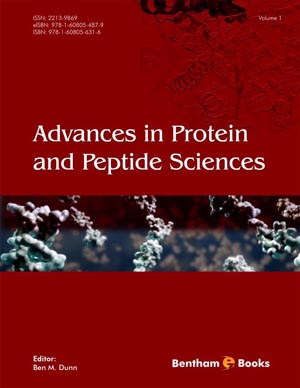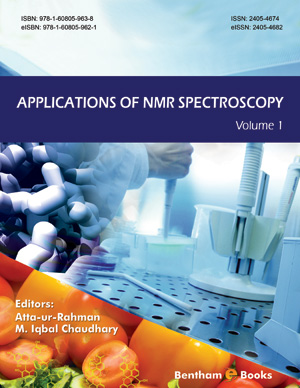Book Volume 1
Photochemical Activation of Functional Groups
Page: 3-23 (21)
Author: Christian G. Bochet
DOI: 10.2174/978160805197710501010003
Abstract
Light is a powerful activator for many standard and non-standard organic transformations. This review focuses on the photochemical activation of organic reactions that can also occur thermally, in particular isomerization, acylation, hydrolysis, ionization, enolization and aromatic substitutions. Asymmetric reactions with polarized light will also be briefly discussed.
Pressure Activation in Organic Synthesis
Page: 25-80 (56)
Author: Gerard Jenner
DOI: 10.2174/978160805197710501010025
Abstract
High pressure activation is presented as a potent synthetic strategy depending on the magnitude of the activation volume. Coupling of high pressure with ancillary activation methods such as catalysis widens the methodology. The application fields are reviewed: Diels-Alder reactions, 1,3- dipolar cycloadditions, [2+2] cycloadditions, Michael and related reactions, Baylis-Hillman additions etc... Many valuable substances can be synthesized in this way. Some recent developments are outlined, directed toward generation of pressure by water freezing, supramolecular chemistry, inhibition of steric hindrance.
Ultrasound in Synthetic Organic Chemistry
Page: 81-117 (37)
Author: Werner Bonrath and Roberto A. Paz Schmidt
DOI: 10.2174/978160805197710501010081
Abstract
In the present chapter an overview about various ultrasound assisted reactions are given. Based on fundamental physical principles modern trends in various reaction types are discussed. Especially typical aspects for scaling up ultrasound-assisted reactions are presented.
Activation of Organic Reactions by Microwaves
Page: 119-171 (53)
Author: Antonio de la Hoz, Angel Diaz-Ortiz and Andres Moreno
DOI: 10.2174/978160805197710501010119
PDF Price: $15
Abstract
Microwave irradiation has been successfully applied in organic chemistry. Spectacular accelerations, higher yields under milder reaction conditions and higher product purities have all been reported. Indeed, a number of authors have described success in reactions that do not occur by conventional heating and even modifications of selectivity (chemo-, regio and stereoselectivity). An overview of the application of microwave irradiation in organic synthesis and the combination with other synthetic methodologies is included. The effect of microwave irradiation in organic synthesis is a combination of thermal effects, arising from the heating rate, superheating or “hot spots”, the selective absorption of radiation by polar substances and the existence of non-thermal effects of the highly polarizing radiation – the “specific microwave effect”. Such phenomena are not usually accessible by classical heating.
Activation of Reactions by Lewis Acids Derived from Ga, In, Sb and Bi
Page: 173-214 (42)
Author: Teck-Peng Loh and Guan-Leong Chua
DOI: 10.2174/978160805197710501010173
PDF Price: $15
Abstract
The Lewis acids derived from Ga, In, Sb and Bi were slowly replacing “traditional” Lewis acids. The reaction conditions using such Lewis acids are usually mild and compatible with much functionality. In addition, these Lewis acids frequently show unique chemistry, which foster niche applications and prompt further research into their chemistry.
Activation of Organic Reactions by Perchlorates
Page: 215-232 (18)
Author: Suvarna S. Deshpande and Anil Kumar
DOI: 10.2174/978160805197710501010215
PDF Price: $15
Abstract
Perchlorates have been frequently employed to promote a variety of synthetic transformations under ambient conditions. For example, the LiClO4-diethyl ether solvent medium has proven to be a powerful substitute for external high pressure for Diels-Alder reactions and other organic reactions. In this chapter are discussed several such organic transformations where perchlorates have played highly significant role in promoting their rates and yields.
Improved Catalytic Performances of Supported Catalysts
Page: 233-260 (28)
Author: Choong Eui Song and Yil Sung Park
DOI: 10.2174/978160805197710501010233
PDF Price: $15
Abstract
The immobilization of homogeneous catalysts on supports is used to facilitate the catalyst separation from reaction mixtures and their recycling. In addition to this practical merit, some reports have demonstrated that the immobilization of a catalyst can also positively influence catalytic performance (increase in catalytic activity, stability and selectivity). In this chapter, the positive effects of immobilization on catalytic efficiency are discussed in terms of site-isolation, steric constraints, cooperation effect and imprinting effects, etc., with the aim to understand as to how such effects lead to positive changes in catalytic properties.
Recent Developments in Asymmetric Hydrogenation of C=O Motif Compounds
Page: 261-299 (39)
Author: Fuk Yee Kwong, Liqin Qiu, Wai Har Lam and Albert S. C. Chan
DOI: 10.2174/978160805197710501010261
PDF Price: $15
Abstract
Catalysis plays a vital role in chemical transformation. The discovery of the Wilkinson catalyst, Rh(Ph3P)3Cl, for hydrogenation stimulated a lot of attempts to develop the enantioselective version of these reactions by using optically active transition metal complexes [1]. In the beginning, only very low enantioselectivity was obtained in the hydrogenation of 2-phenylacrylic acid and 2-phenyl-1-propene with certain chiral tertiary phosphine rhodium complexes as catalysts [2]. However, the situation was dramatically changed by the invention of well-designed Rh complexes. This chemistry later became the standard method for the synthesis of optically active amino acids. In particular, the discovery of Ru-BINAP complexes in the mid 80’s significantly expanded the scope of asymmetric hydrogenation [3]. High rates of reduction of C=X functional groups were attainable only by the coordination of structurally well-designed catalysts and suitable reaction conditions. The use of appropriate chiral diphosphine ligands, particularly the BINAP class compounds, and chiral diamines resulted in rapid and productive asymmetric hydrogenation of a range of aromatic and heteroaromatic ketones and gave consistently high enantioselectivity. Certain amino and alkoxy ketones were also used as the substrates. In fact, this asymmetric transformation tolerated many substituents including F, Cl, Br, I, CF3, OMe, OBn, COOCH(Me)2, NO2, NH2, and NRCOR as well as various electron-rich and -deficient aromatics. In addition, cyclic and acyclic a,b-unsaturated ketones were converted to chiral allyl alcohols of high enantiomeric purity. Particularly noteworthy was that the hydrogenation of configurationally labile ketones allowed for the dynamic kinetic discrimination of diastereomers, epimers and enantiomers. This important method showed promise in the synthesis of a wide variety of chiral alcohols from achiral and chiral carbonyl compounds. Its versatility was further manifested by the asymmetric synthesis of many biologically active chiral compounds. These scientifically interesting and industrially attractive processes have been recently applied to the synthesis of various natural and unnatural chiral compounds in a practical manner.
Supramolecular Catalysis of Organic Reactions Involving Cyclodextrins
Page: 301-339 (39)
Author: K. Rama Rao, Y. V.D. Nageswar, N. Srilakshmi Krishnaveni and K. Surendra
DOI: 10.2174/978160805197710501010301
PDF Price: $15
Abstract
Supramolecular catalysis by cyclodextrins involving non-covalent inter molecular forces and host-guest complexation has been shown to result in high selectivities in a variety of organic reactions by the cyclodextrin molecular recognition ability and effective use of their hydroxyl groups and derivatives. Some of the applications of cyclodextrins discussed are: enzyme models, enzyme catalysed reactions, regioselective ring opening reactions, photo chemical reactions, oxidations, enantioselective reactions etc. Recent developments in the modification of cyclodextrins to attain good geometric control for accelerating the reactions has been highlighted.
Solvophobic Activation in Organic Synthesis
Page: 341-401 (61)
Author: Marie Christine Scherrmann, Stephanie Norsikian and Andre Lubineau
DOI: 10.2174/978160805197710501010341
PDF Price: $15
Abstract
Review of organic reactions in which solvophobic effects could be implied in the activation process is presented with a particular emphasis on reactions performed in water.
Organic and Metal-Catalysed Electrosynthesis
Page: 403-453 (51)
Author: Claude Moinet, Jean-Pierre Hurvoisa and Anny Jutand
DOI: 10.2174/978160805197710501010403
PDF Price: $15
Abstract
Reactive intermediates such as carbocations, carbanions, radicals and radical ions can be electrochemically generated from various electroactive species. Those intermediates may react chemically (C) or electrochemically (E) according to EC, ECE mechanisms. Anodic oxidations produce acidic or electrophilic species, which can react with nucleophiles or (and) eliminate protons or electrophiles. Cathodic reductions afford basic or nucleophilic species, which can react with protons or electrophiles or (and) eliminate nucleophiles. In this way, functional group conversion, substitution reactions, addition reactions, cleavage reactions and coupling reactions can be selectively performed by using direct electrolyses. Activation by transition-metal catalysts is required when the organic substrate is not electroactive or leads to non desired reactions. The metalcatalysed electrosynthesis proceeds by a double activation: i) chemical activation of the organic substrate by the electrogenerated active form of a transition metal catalyst that generates an organometallic species more easily reduced than the organic substrate, ii) followed by activation by electron transfer of the organometallic species formed in the previous chemical activation step. This double chemical and electrochemical activation causes new reactions to proceed, which involve either the classical organic reactive species, produced in any electrochemical steps (carbanions) or organometallic complexes (anionic or neutral) as the basis of new reactivity.
Biocatalysis in Organic Synthesis
Page: 455-518 (64)
Author: Robert Azerad
DOI: 10.2174/978160805197710501010455
PDF Price: $15
Abstract
Biocatalytic reactions using enzymes or whole microbial cells are increasingly employed for organic synthesis, taking advantage of their high versatility and exquisite selectivities (chemo-, regio- and stereoselectivity). Resolution of racemates and its refinements, desymmetrisation of meso- and prochiral compounds by oxidoreduction, some C-C bond forming reactions and other miscellaneous reactions will be outlined, illustrating the most characteristic aspects of environmentally friendly and yield-effective production of commodity chemicals, stereospecific building blocks or intermediates, and competitive step-replacement strategies for asymmetric syntheses.
Tactical Approaches to Catalytic Antibodies
Page: 519-540 (22)
Author: Veronique Gouverneur and Maud Reiter
DOI: 10.2174/978160805197710501010519
Abstract
In this chapter, we describe some of the general strategies implemented by the experimenter to challenge the immune system for the production of antibodies that act as catalysts. Some representative strategies include the use of haptens that are transition state analogues, the “bait and switch” strategy and the concept of “reactive immunisation”. These protocols have allowed the preparation of catalytic antibodies for various synthetic transformations including reactions for which there is no enzymatic catalyst available. In addition to its value for synthesis, this area of research provides an opportunity to better understand the rules of enzyme catalysis.
Introduction
Advances in Organic Synthesis is a book series devoted to the latest advances in synthetic approaches towards challenging structures. It presents comprehensive articles written by eminent authorities on different synthetic approaches to selected target molecules and new methods developed to achieve specific synthetic transformations. Contributions are written by eminent scientists and each volume is edited by an authority in the field. Advances in Organic Synthesis is essential for all organic chemists in the academia and industry who wish to keep abreast of rapid and important developments in the field.






















